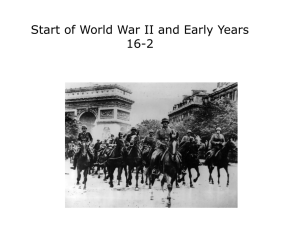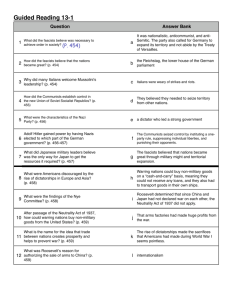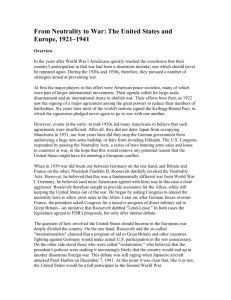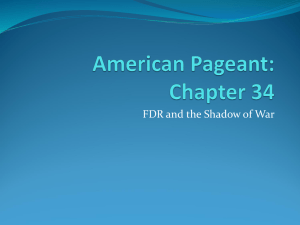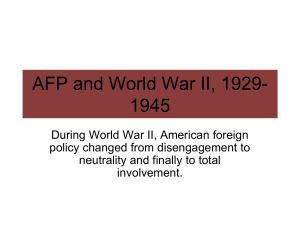Chapter 34 Classwork Name: _________________________________________ US HISTORY AP
advertisement
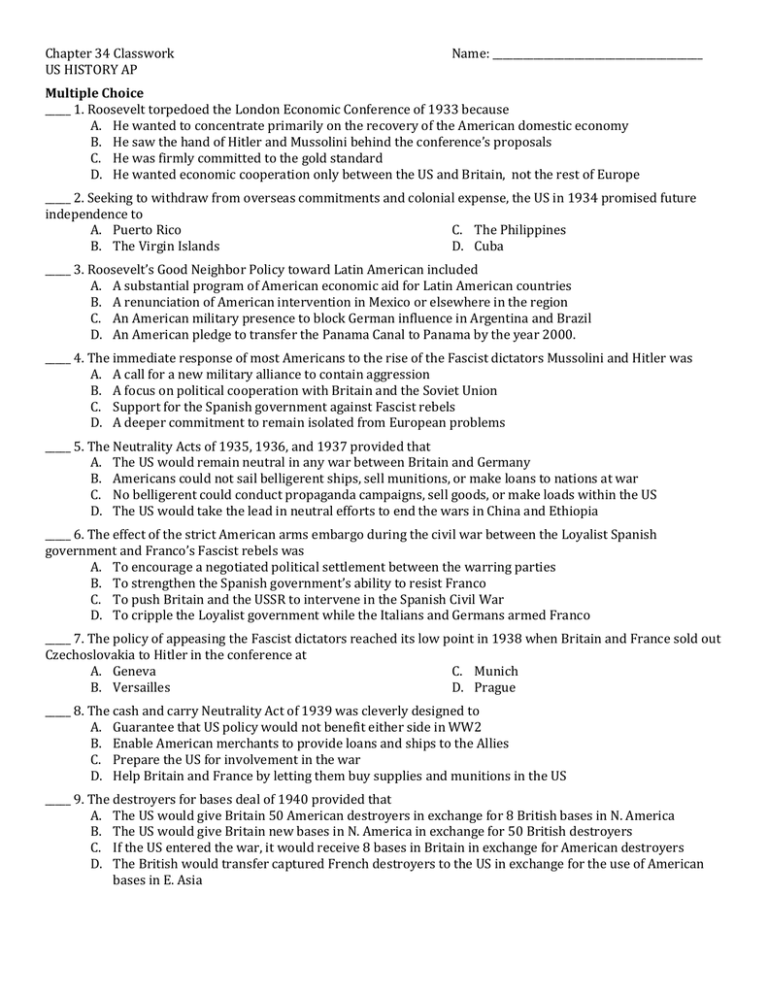
Chapter 34 Classwork US HISTORY AP Name: _________________________________________ Multiple Choice _____ 1. Roosevelt torpedoed the London Economic Conference of 1933 because A. He wanted to concentrate primarily on the recovery of the American domestic economy B. He saw the hand of Hitler and Mussolini behind the conference’s proposals C. He was firmly committed to the gold standard D. He wanted economic cooperation only between the US and Britain, not the rest of Europe _____ 2. Seeking to withdraw from overseas commitments and colonial expense, the US in 1934 promised future independence to A. Puerto Rico C. The Philippines B. The Virgin Islands D. Cuba _____ 3. Roosevelt’s Good Neighbor Policy toward Latin American included A. A substantial program of American economic aid for Latin American countries B. A renunciation of American intervention in Mexico or elsewhere in the region C. An American military presence to block German influence in Argentina and Brazil D. An American pledge to transfer the Panama Canal to Panama by the year 2000. _____ 4. The immediate response of most Americans to the rise of the Fascist dictators Mussolini and Hitler was A. A call for a new military alliance to contain aggression B. A focus on political cooperation with Britain and the Soviet Union C. Support for the Spanish government against Fascist rebels D. A deeper commitment to remain isolated from European problems _____ 5. The Neutrality Acts of 1935, 1936, and 1937 provided that A. The US would remain neutral in any war between Britain and Germany B. Americans could not sail belligerent ships, sell munitions, or make loans to nations at war C. No belligerent could conduct propaganda campaigns, sell goods, or make loads within the US D. The US would take the lead in neutral efforts to end the wars in China and Ethiopia _____ 6. The effect of the strict American arms embargo during the civil war between the Loyalist Spanish government and Franco’s Fascist rebels was A. To encourage a negotiated political settlement between the warring parties B. To strengthen the Spanish government’s ability to resist Franco C. To push Britain and the USSR to intervene in the Spanish Civil War D. To cripple the Loyalist government while the Italians and Germans armed Franco _____ 7. The policy of appeasing the Fascist dictators reached its low point in 1938 when Britain and France sold out Czechoslovakia to Hitler in the conference at A. Geneva C. Munich B. Versailles D. Prague _____ 8. The cash and carry Neutrality Act of 1939 was cleverly designed to A. Guarantee that US policy would not benefit either side in WW2 B. Enable American merchants to provide loans and ships to the Allies C. Prepare the US for involvement in the war D. Help Britain and France by letting them buy supplies and munitions in the US _____ 9. The destroyers for bases deal of 1940 provided that A. The US would give Britain 50 American destroyers in exchange for 8 British bases in N. America B. The US would give Britain new bases in N. America in exchange for 50 British destroyers C. If the US entered the war, it would receive 8 bases in Britain in exchange for American destroyers D. The British would transfer captured French destroyers to the US in exchange for the use of American bases in E. Asia _____ 10. The twin events that precipitated the reversal of American policy from neutrality to active, though nonbelligerent, support of the Allied cause were A. The Munich Conference and the invasion of Poland B. The fall of France and the Battle of Britain C. The fall of Poland and the invasion of Norway D. The invasion of the USSR and the German u-boat attacks on US shipping _____ 11. In the campaign of 1940, the Republican nominee Willkie essentially agreed with FDR on the issue of A. the New Deal C. Roosevelt’s use of power in office B. the third term D. foreign policy _____ 12. The Lend-Lease Act clearly marked A. The end of isolationist opposition to Roosevelt’s foreign policy B. An end to the pretense of American neutrality between Britain and Germany C. A secret Roosevelt plan to involve the US in the war with Japan D. The beginning of opposition in Congress to FDR’s foreign policy _____ 13. The provisions of the Atlantic Charter signed by FDR and Churchill in 1941 included A. Self-determination for oppressed peoples and a new international peacekeeping organization B. A permanent alliance between Britain, the US, and the USSR C. A pledge to rid the world of dictators and to establish democratic governments in Germany and Italy D. An agreement to oppose Soviet communism, but only after Hitler was defeated _____ 14. By the fall of 1940, American warships were being attacked by German destroyers near the coast of A. Spain C. Iceland B. Ireland D. Canada _____ 15. The key issue in the failed negotiations with Japan just before Pearl Harbor was A. The refusal of the Japanese to withdraw their navy from Hawaiian waters B. Americans’ insistence on their right to expand naval power in Asia C. The Japanese refusal to withdraw from China D. The Japanese refusal to guarantee the security of the Philippines Matching People Places, and Events A. Courageous prime minister who led Britain’s lonely resistance to Hitler B. Leader of the “America First” organization and chief spokesman for US isolationism C. African nation invaded by an Italian dictator in 1935 D. Dynamic dark horse Republican presidential nominee who attacked FDR only on domestic policy E. Fanatical Fascist leader of Germany whose aggressions forced the US to abandon its neutrality F. Instigator of 1934 Senate hearings that castigated WW1 munitions manufacturers as merchants of death G. Nation whose sudden fall to Hitler in 1940 pushed the US closer to direct aid to Britain H. Site of a naval vase where Japan launched a devastating surprise attack on the US I. North Atlantic nation near whose waters US destroyers came under Nazi submarine attack J. Small East European democracy betrayed into Hitler’s hands at Munich K. The lesser partner of the Rome-Berlin Axis who invaded Ethiopia and joined the war against Britain and France L. FDR’s Secretary of State who promoted reciprocal trade agreements, especially with Latin America M. Russian dictator who first helped Hitler destroy Poland before becoming a victim of Nazi aggression in 1941 N. East European nation whose Sept 1939 invasion by Hitler set off WW2 in Europe O. Fascist rebel against the Spanish Loyalist government _____ 1. Cordell Hull _____ 2. Adolf Hitler _____ 3. Benito Mussolini _____ 4. Gerald Nye _____ 5. Fransisco Franco _____ 6. Ethiopia _____ 7. Czechoslovakia _____ 8. Poland _____ 9. France _____ 10. Charles Lindbergh _____ 11. Wendell Willkie _____ 12. Winston Churchil _____ 13. Joseph Stalin _____ 14. Iceland _____ 15. Hawaii Matching Cause and Effect A. Thrust the US into an undeclared naval war with Nazi Germany in the North Atlantic B. Prompted FDR to make his Quarantine Speech proposing strong action against aggressors C. Brought new respect for the US and for democracy in Latin America D. Shocked the US into enacting conscription and making the destroyers for bases deal E. Forced Japan to either accept US demands regarding China or go to war F. Caused the US to institute a cash and carry policy for providing aid to Britain G. Deepened the worldwide Depression and aided the rise of Fascist dictators H. Actually aided Fascist dictators in carrying out their aggressions in Ethiopia, Spain, and China I. Promoted US isolationism and the passage of several Neutrality Acts in the mid-1930s J. Kept the 1940 presidential campaign from becoming a bitter national debate _____ 1. FDR’s refusal to support international economic cooperation in the 1930s _____ 2. Roosevelt’s Good Neighbor policy _____ 3. Bad memories of WW1 and revelations about arms merchants _____ 4. The US Neutrality Acts of the 1930s _____ 5. Japanese aggression against China in 1937 _____ 6. Hitler’s invasion of Poland _____ 7. The fall of France in 1940 _____ 8. Willkie’s support for FDR’s pro-British foreign policy _____ 9. The US embargo on oil and other supplies to Japan _____ 10. Roosevelt’s decision to convoy lend-lease shipments Identification ______________________ 1. International economic conference on stabilizing currency that was sabotaged by FDR ______________________ 2. Nation to which the US promised independence in the Tydings-McDuffie Act of 1934 ______________________ 3. FDR’s repudiation of Teddy Roosevelt’s corollary to the Monroe Doctrine, stating his intention to work cooperatively with Latin American nations ______________________ 4. A series of laws enacted by Congress in the mid-1930s that attempted to prevent any American involvement in future overseas wars ______________________ 5. Conflict between the rebel Fascist forces of Franco and the Loyalist govt that severely tested US neutrality legislation ______________________ 6. Roosevelt’s 1937 speech that proposed strong US measures against overseas aggressors ______________________ 7. European diplomatic conference in 1938 where Britain and France conceded to Hitler’s demands for Czechoslovakia ______________________ 8. Term for the British-French policy of attempting to prevent war by granting German demands ______________________ 9. Leading US group advocating American support for Britain in the fight against Hitler ______________________ 10. Leading isolationist group advocating that America focus of continental defense and noninvolvement with the European war ______________________ 11. Controversial 1941 law that made America the “arsenal of democracy” by providing supposedly temporary military material assistance to Britain ______________________ 12. Communist nation invaded by Hitler in June 1941 that was aided by American lend-lease ______________________ 13. US-British agreement of Aug 1941 to promote democracy and establish a new international organization for peace ______________________ 14. US destroyer sunk by German submarines off the coast of Iceland in Oct 1941, with the loss of over a hundred men ______________________ 15. Major American Pacific naval base devastated in a surprise attack in Dec 1941


